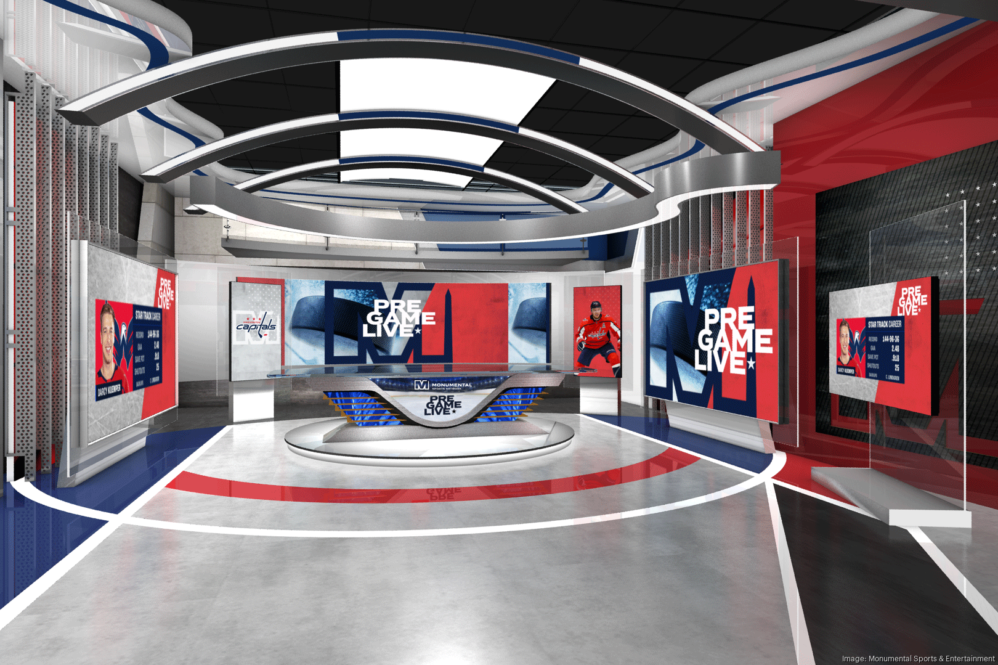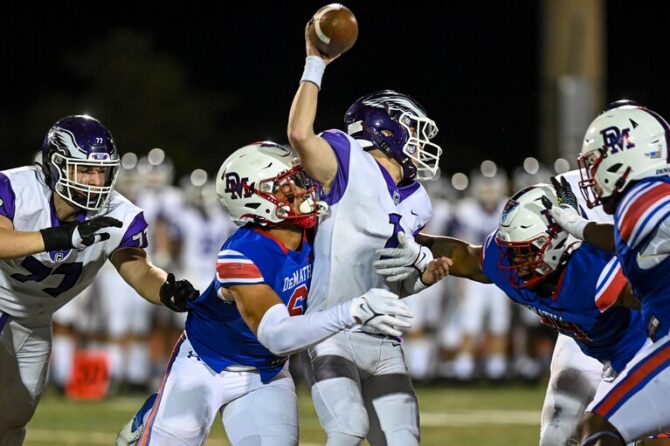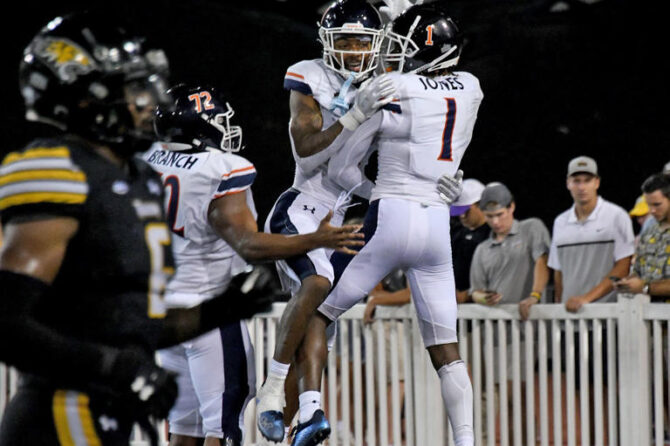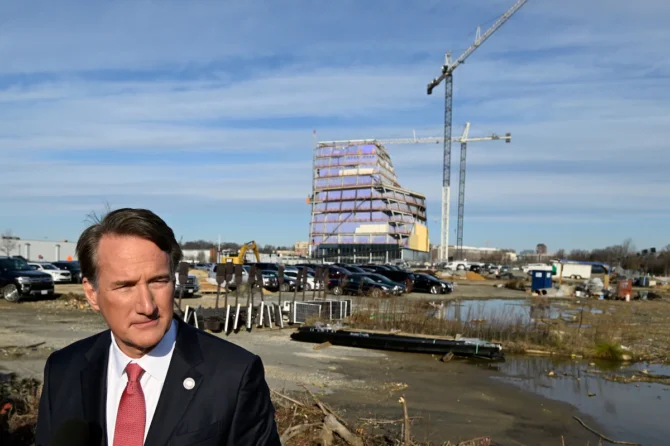WASHINGTON BUSINESS JOURNAL: There’s a new channel in town for D.C. sports.
It’s been quite a year for Zach Leonsis.
As president of media and new enterprises for Monumental Sports & Entertainment, he oversaw the company’s acquisition and rebranding of NBC Sports Washington into Monumental Sports Network.
The channel launched Sept. 20 and began streaming in October.
The company, which owns the Washington Wizards and Capitals and is led by Zach’s father, Ted Leonsis, bought NBC Sports Washington from Comcast and NBCUniversal in September 2022. Monumental previously owned 33% of the channel.
The deal — which included the network’s employees, network distribution agreements and even some equipment — provided for a 12-month transition agreement. Monumental spent the year building its own production infrastructure and systems and started construction on a new studio space, which should be completed in January.
“Even though we felt like we had a shot clock over our heads in terms of getting off of our transition services agreement, we also took it as an opportunity to take a step back and really reimagine and rethink how do we want to build the regional sports network for the future,” Zach Leonsis said.
Monumental enlisted an outside marketing agency, Rockville-based HZ, to run focus groups and surveys before deciding on the final logo and brand. California-based Two Fresh Creative Inc. developed 4K-quality graphics and animations incorporating the new branding to use on-air.
The channel showcases new live game features, including players and coaches mic’d up during games and camera angles from the press box and even the crash box — the rinkside spot where sideline reporters often stand.
It features pregame and postgame shows with more player interviews, traveling sideline reporters on the ground at all games, and more advanced analytics.
Sportscaster and journalist Rachel Nichols also hosts the new “Hometown with Rachel Nichols” interview series on Monumental Sports Network.
Viewers can catch the channel through their local cable provider or subscribe directly for $19.99 per month or $199.99 per year. The new streaming platform is available online and on Android, Roku, Apple TV and Fire TV with more availability coming soon.
About the new space
Monumental is building out a new broadcast studio next to Capital One Arena at Gallery Place. It will feature:
- Two stories with two studios and five production control rooms capable of 4K HDR productions with full graphics and video quality of 1080p (shooting at 60 frames per second)
- An audio-over-IP platform capable of 1,536 channels of digital signal processing
- Production studios outfitted with pan/tilt robotics, RED production cameras for capturing 4K HDR, and 1.9-pixel pitch LED walls in a custom-built hardscape
- 10 replay positions, each capable of 6×2 channels of replay and three-phase super slow motion
Q&A with Zach Leonsis
How much of a change will this channel’s programming be from what you offered online before the acquisition? If you take a look at our programing prior to our acquisition, we actually already had the biggest production team in the NBA and the NHL. We were already producing hundreds of hours of programming for our social channels, for our team websites. And we were able to take a step back with the network team and the existing production group we have and rationalize and consolidate all of those original programming efforts to enhance our [programming]. Prior to the transition, our air looked like it really leveraged a lot of third-party content.
How do you mean? You’d see a lot of infomercials and then it would lead into pre-game, the live game and the post-game. And I think that we feel like our fans deserve a network that provides more than that. It’s not just a placeholder for live games. We’ve got exclusive access and lots of footage that we want to be able to leverage. That’s good for fans, it’s good for advertisers, it’s good for our distribution partners. It also enhances our direct-to-consumer bundle. So our 24-7 linear experience now is far more fan-friendly. When you tune in to our network at 12 noon on a weekday, there’s something for you to watch. And I think we want to give people permission to enjoy being a Caps or Wizards fan.
What else is new? We are still in the middle of building out a brand new office space for Monumental that will include a brand new production plant that will be best in class, really state-of-the-art to the industry. It will be what’s called IP-based, leveraging remote cloud and virtual machine technology. And it will feature what I would describe as a major league studio experience. It will feature two studios that are back-to-back that can be combined when we don’t have [two games on one night]. And then when we do have Capitals and Wizards games happening on the same night, it can be split in two with the wall that projects down and will shoot both ways. But both of those studio spaces will be a significant upgrade over what the network has had previously.
How about the picture quality? We’ll also be upgrading our video quality from 1080i to 1080p, which will feel like true HD much closer to the 4K that people think they watch on television today in a national broadcast. It’s not really 4K, but it’s 1080p and people can notice the difference. And we’ll also launch alternate broadcasts for the Capitals and Wizards as well.
What do you say to people who think local sports networks are fading away? People are just watching on many different channels. And the channels in which people watch are just fragmented as opposed to linear cable being a single source for viewership. People are increasingly more and more used to streaming and going direct to consumer, cobbling together their own unique bundle of Netflix and Hulu and Monumental Sports Network now for their sports. And we believe there will be additional distribution channels in the future with more digital partners and league partnerships and the like.
What has been the biggest challenge in rolling all this out? I think one of the biggest obstacles or challenges that we faced was the long lead time needed. For example, with this new production facility that we hope to debut in the second half of January, I began this process in May of 2022, even prior to signing and closing on the acquisition of the network, because I was being advised that the lead times on some of this equipment was well over a year — 14, 15 months. So we were cutting loose and ordering big ticket items around Labor Day of 2022 — and we’re just receiving them last month and this month, which is unbelievable that you’ve got to plan that far ahead.
How big a setback is that to your plans? In a perfect world, we would have had our production plant and studio space open in time for the start of the season. But we knew that was an impossibility based on Covid supply chain issues — and the war in Ukraine actually diverted a lot of raw material towards military equipment as opposed to production equipment, as you can imagine. I think we swiftly navigated those items. And we’ve come up with the current stopgap solution that we’ve been using for our pre- and postgame shows, which we’ve been filming out of District E, our new esports theater. But I’m very anxious for us to move into our new facility and digs. I think it will finally feel like we’ve completed our transformation. I still feel like we’re only 50 or 60% of the way there.
What went into launching the streaming platform? We soft-launched our digital streaming platform in August. We wanted to do sort of a quiet public beta [test], uncover bugs, receive customer issues. You have to understand that there are literally hundreds of different device types, model numbers, previous hardware versions with different levels of software and whatnot and operating systems. So it’s a really, really difficult task to make sure everything works for everyone. But I think we accomplished a lot in that period, and we certainly squashed a lot of bugs in the lead up to a direct-to-consumer launch. It was really important for us to make sure direct-to-consumer rolled out smoothly because you’re taking people’s actual credit card information and charging them money and people expect the things to work.
And is that going smoothly so far? I would say for 98 to 99% of our users, we’ve had no issues. We do have edge cases that we’re working to tackle every day. And we’ve got one more app update coming in just a couple weeks, which we think will actually solve the remaining bugs for those edge cases, which is nice.
Are there advantages to using the digital platform over the linear one? Linear is a great way to experience video, but digital provides a neat functionality that linear can’t. And so we’ve really tried to leverage that in terms of offering users the ability to watch multiple camera angles, access real-time data and statistics on what’s happening in the field of play. When we launch our alternate feeds in the new year, people will be able to toggle back and forth between things. We imagine one day being able to launch a multiview system so you can watch a Capitals and a Wizards game at the exact same time right next to each other.
Anything else on your wish list to develop? I can imagine one day gamification being an important part of the live viewing experience for digital. I could imagine rolling out additional direct-to-consumer bundles with varying product types and whatnot. I’d love to see us continue to expand upon our digital product and just make it better with more functionality. Empower our users more and more and more. I’d love to see us acquire more programing. More live programing.
What do you think might surprise people who don’t work in the sports business? So people who work in sports work long hours, work odd hours, work weekends, work every day. When you work in sports, you’ve got to love it. If you don’t love it, you’re probably burned out. But we’re having fun. It’s been a lot of work, but it’s been the type of work you want to do. It’s easier to exert effort playing offense than defense.










